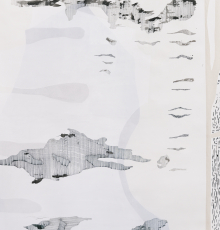Let There be Night

Amelie Bouvier's upcoming solo exhibition at Harlan Levey Projects 1050 reflects upon our relationship with the cosmos, the transmission of knowledge, and ever-increasing problems of pollution in our night sky. The show reunites works from three different periods of the artist's practice, working over three different types of media: drawing, video, and object. The two-channel video Eight Minutes Ago is the oldest work, completed after a research trip to the Harvard & Smithsonian Astronomical Photographic Plate Collection in January 2019. Juxtaposing the photographic glass plates in the archives with a personal recollection of night by a 93 year old, Bouvier compares one's personal memories to the collective memory of societies, which are curated and passed down in an organized manner. Treating memory, its archiving, its strength and importance while evoking its fragility and disappearance, this video lays the groundwork for the body of drawings on canvas which will be shown for the first time. Related to a previous body of works, Pickering's Harem, which revealed the fraught role of women in science, and notably astronomy, Serapis looks at the state of the research done by these women today. Inspired by damaged photographic plates at the Harvard library, which are still around but now devoid of their primary function, Bouvier investigates the preservation of data, and how we deem that something may no longer have usage or importance. The delicateness and flexibility of these glass plates are translated on the surface of un-stretched canvases, either hung on the wall or floating on supports in the space, as this lost data is suspended in time, without the opportunity to be passed on to future generations. Layers of ink and paint refer to the markings of these scientists and the flaking forms of photographic emulsion that remain. Let There be Night refers to the relationship between light and dark, knowledge and its lack of transmission, and the ever-growing need for a critical approach to light pollution, brought about by concerns of safety, satellites, and other devices thought for human comfort. In astronomy, we need the night in order to discover what is above, but true darkness is becoming extinct. In addition, the discarded satellites which orbit the earth are making it more and more difficult to see the cosmos, even with a telescope. Should we continue upon this same trajectory, soon it will be impossible to study the sky, as we are constantly filling it with more objects. Bouvier will be exhibiting a new series of objects which take the form of music boxes, in which satellites break up the compositions created by the night sky. Intrigued by how much the scientific notations on the photographic plates were reminiscent of musical partitions Bouvier elaborated this correlation during a residency at the Observatory of Namur. These works reveal the Belgian sky both before and after the disruptions caused by this space trash. Taken together with the works based on nineteenth century research, Bouvier's work encourages us to think about questions of preservation, knowledge, and what we choose to pass on to future generations.









Comments
The exhibition runs from 04/11 till 18/12/2021.
Opening hours: Wed - Sat, 11 - 18h